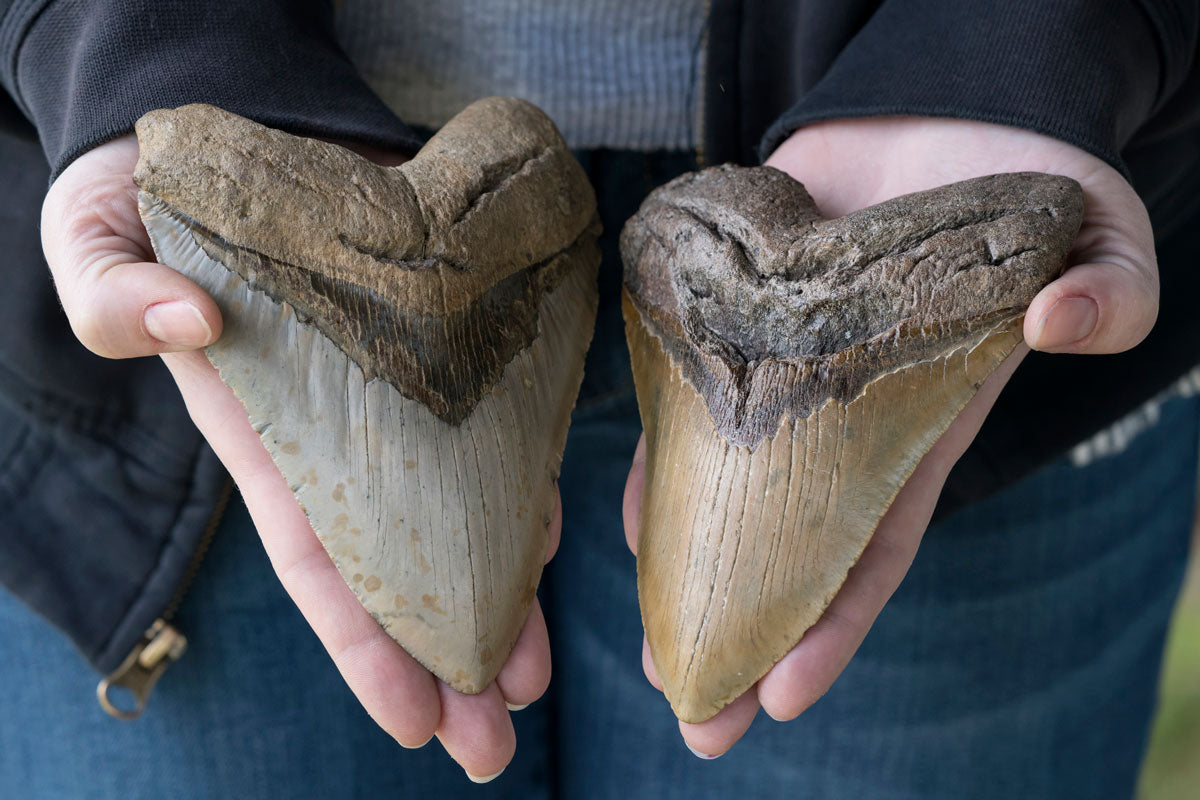
Megalodon Shark Teeth, a Fossil to Save
Do you remember where you were the first time you realized that the whale with a unicorn horn from the movie “Elf” was a real animal? The iconic line, “Bye, Buddy, hope you find your dad,” affectionately uttered by Mr. Narwhal, left many moviegoers assuming it was an imaginary animal. That same realization happens daily when people discover that Megalodon sharks are real.
If you’re one of the people that read that last sentence and your jaw dropped, no judgment. Megalodon sharks went extinct over 2.6 million years ago, so it makes sense that they’re commonly given myth status.
What is a Megalodon Shark?

The name Megalodon translates to “Large Tooth,” which is fitting considering a Megalodon tooth can measure over 7 inches long; they are the largest fish ever to exist. In comparison, a great white shark tooth measures an average of 2.1 inches in length. If that's not impressive enough, the Megalodon was about three times longer than the average great white shark.
Sharks have an endless supply of teeth and can have more than 40,000 teeth in a lifetime. The constant regeneration of teeth means the most popular Megalodon fossils are Megalodon teeth.
Why did Megalodon Sharks Become Extinct?
The larger the animal, the more sustenance they need to survive. During the Cenozoic era, a passageway connected the Pacific Ocean to the Caribbean Sea. This allowed water, plants, and animals to move between the two oceans freely.
During the Pliocene, the Pacific tectonic plate moved next to the Caribbean and South American plates resulting in volcanic activity that led to the creation of mountains that stretched from North to South America. As a result of the tectonic plate movement, the Caribbean Sea was cut off from the Pacific Ocean, creating a division of species that made it impossible for the Megalodon to sustain its lifestyle.
Where Can I Find a Megalodon Tooth?
Island life comes with many perks, and one of them includes direct access to the incredible ocean. We are constantly searching for Megalodon teeth and fossils to share with our fellow fossil lovers from all over the world.
The beauty of Megalodon teeth is in their size, coloring, and design. The striated pattern on the tooth bone matched with a contrasting shiny root in black, brown, or white gives them a unique and artistic flair.
Top 5 Places to Find Megalodon Teeth:
- Hawaii
- Maryland
- South Carolina
- Florida
- Washington, D.C. - Smithsonian Museum, for those that want to look but not take home
Megalodon Teeth, But Make it Fashion

Our favorite Megalodon tooth is this stunning find that measures over 6 inches. It has been modified with pyrite and turquoise pieces to give it a stunning appearance, perfect for a home décor item that will be an instant conversation starter.
A classic way to collect smaller shark or Megalodon teeth is by wearing them on necklaces, so we offer a variety of pendant-style Megalodon tooth options. Our blue-black tooth is a top pick, with a glossy root that gives it a trendy yet classic vibe.
Choosing the Best Megalodon Teeth for Your Collection
When shopping for Megalodon teeth, there are a few things to consider: size, color, and purpose. The purpose is typically the first thing to decide. For example, do you want something to wear, a piece of office decor, or a new addition to an established or budding collection? Once you make this choice, you can decide what size and color would be best for your situation.
If you want it for your office, you might want to go on the larger size to double as a paperweight. On the other hand, if you're adding to your collection, you probably want something that fills a gap in either size or color. Our bone valley pendants are great contrasting pieces that pop.
5 Fascinating Facts About Megalodon Sharks:
- Megalodon fossil remains have been found on every continental coast except Antarctica.
- Megalodon sharks did not have bones. Instead, all shark skeletons are made of cartilage.
- Megalodon sharks were apex predators that survived off eating whales, dolphins, seals, and other large marine animals.
- President Thomas Jefferson owned a Megalodon tooth; it now resides at The Academy of Natural Sciences of Drexel University in Pennsylvania.
- The full name for a Megalodon shark is "Carcharocles megalodon," which translates to "big tooth glorious shark."
Bonus fun fact: there's a genus of clams called "Megalodon," although they're not quite as intimidating as the Megalodon sharks we're talking about.
How Strong is a Megalodon Shark Bite?

Okay, so we know Megalodons are literally the largest fish, and they have massive teeth, but how fierce is their bite? Paleontologists completed biomechanical modeling based on Megalodon teeth and calculated their bite force to be roughly 40,000 pounds per square inch (psi), the highest bite force for any animal. The bite force of a great white shark is 4,000 psi, and the bite force of a Tyrannosaurus Rex is a measly 12,800 psi in comparison.
The size of a Megalodon's mouth is nearly 10 feet wide. If they were alive today, they could easily swallow a small car whole. Not only that, but they could chomp a boat in half with ease. Sailors, seaman, and recreational boaters can all take a collective sigh of relief that Megalodons are extinct.
Megalodon Sharks got That Big Big Energy

The largest fish to ever exist, the largest apex predator, and the largest bite force of any animal ever. It's no wonder professional paleontologists and casual beachgoers alike are fascinated by their massive fossilized teeth. So next time you're visiting Hawaii, take a stroll along the beach to see if you can spot a Megalodon tooth. If not, no worries, we have an incredible collection for you to choose from.
Keep this article handy for your next trivia night, so you can impress everyone with your big fish knowledge and take a bite out of the competition.

